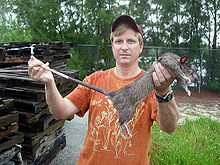Gambian pouched rat
| Gambian pouched rat | |
|---|---|
 | |
| A Gambian pouched rat in captivity | |
Conservation status | |
 Least Concern (IUCN 3.1)[1] | |
Scientific classification | |
| Kingdom: | Animalia |
| Phylum: | Chordata |
| Class: | Mammalia |
| Order: | Rodentia |
| Family: | Nesomyidae |
| Genus: | Cricetomys |
| Species: | C. gambianus |
Binomial name | |
Cricetomys gambianus Waterhouse, 1840 | |
The Gambian pouched rat (Cricetomys gambianus), also known as the African giant pouched rat, is a nocturnal pouched rat of the giant pouched rat genus Cricetomys, and is among the largest muroids in the world, growing up to about 0.9 metres (3 ft) long including their tail which makes up half their length.[2] It is widespread in Sub-Saharan Africa, ranging geographically from Senegal to Kenya and from Angola to Mozambique (although it is absent from much of the DR Congo, where Emin's pouched rat is present) and in altitude from sea level to 2,000 metres (6,600 ft).[1]
Contents
1 Characteristics
2 Invasive species
3 Ability to detect land mines and tuberculosis by scent
4 See also
5 References
6 External links
Characteristics
The Gambian pouched rat has very poor eyesight and so depends on its senses of smell and hearing. Its name comes from the large, hamster-like pouches in its cheeks. It is not a true rat but is part of an African branch of muroid rodents. It typically weighs between 1 and 1.4 kilograms (2.2 and 3.1 lb).[2] In its native Africa, the pouched rat lives in colonies of up to twenty, usually in forests and thickets, but also commonly in termite mounds. It is omnivorous, feeding on vegetables, insects, crabs, snails and other items, but apparently preferring palm fruits and palm kernels.
Unlike domestic rats, it has cheek pouches like a hamster. These cheek pouches allow it to gather up several kilograms of nuts per night for storage underground. It has been known to stuff its pouches so full of date palm nuts so as to be hardly able to squeeze through the entrance of its burrow. The burrow consists of a long passage with side alleys and several chambers, one for sleeping and the others for storage. The Gambian pouched rat reaches sexual maturity at 5–7 months of age. It has up to four litters every nine months, with up to six offspring in each litter. Males are territorial and tend to be aggressive when they encounter one another.
Invasive species

A Gambian pouched rat killed in the Florida Keys
Gambian pouched rats have become an invasive species on Grassy Key in the Florida Keys,[3] after a private breeder allowed the animals to escape.[4] This outsized African rodent is also believed to be responsible for the 2003 outbreak of monkeypox in the United States, after spreading it to prairie dogs which were purchased as pets. In 2003, the United States' CDC and FDA issued an order preventing the importation of the rodents following the first reported outbreak of monkeypox. Around 20 individuals were affected.[5]
Ability to detect land mines and tuberculosis by scent
A Tanzanian social enterprise founded by two Belgians, APOPO, trains Gambian pouched rats to detect land mines and tuberculosis with their highly developed sense of smell. The trained pouched rats are called HeroRATS. The rats are cheaper to train than mine-detecting dogs; a rat requires $7,300 for nine months of training, whereas a dog costs about $25,000 for training.[6]
Currently studies are being conducted in various countries about the best ways to train these rats, and determine their abilities and limits to detecting mines.
See also
- APOPO
- Giant pouched rat
References
^ ab van der Straeten, E.; Kerbis Peterhans, J.; Howell, K. & Oguge, N. (2008). "Cricetomys gambianus". IUCN Red List of Threatened Species. Version 2009.1. International Union for Conservation of Nature. Retrieved 11 July 2009..mw-parser-output cite.citationfont-style:inherit.mw-parser-output .citation qquotes:"""""""'""'".mw-parser-output .citation .cs1-lock-free abackground:url("//upload.wikimedia.org/wikipedia/commons/thumb/6/65/Lock-green.svg/9px-Lock-green.svg.png")no-repeat;background-position:right .1em center.mw-parser-output .citation .cs1-lock-limited a,.mw-parser-output .citation .cs1-lock-registration abackground:url("//upload.wikimedia.org/wikipedia/commons/thumb/d/d6/Lock-gray-alt-2.svg/9px-Lock-gray-alt-2.svg.png")no-repeat;background-position:right .1em center.mw-parser-output .citation .cs1-lock-subscription abackground:url("//upload.wikimedia.org/wikipedia/commons/thumb/a/aa/Lock-red-alt-2.svg/9px-Lock-red-alt-2.svg.png")no-repeat;background-position:right .1em center.mw-parser-output .cs1-subscription,.mw-parser-output .cs1-registrationcolor:#555.mw-parser-output .cs1-subscription span,.mw-parser-output .cs1-registration spanborder-bottom:1px dotted;cursor:help.mw-parser-output .cs1-ws-icon abackground:url("//upload.wikimedia.org/wikipedia/commons/thumb/4/4c/Wikisource-logo.svg/12px-Wikisource-logo.svg.png")no-repeat;background-position:right .1em center.mw-parser-output code.cs1-codecolor:inherit;background:inherit;border:inherit;padding:inherit.mw-parser-output .cs1-hidden-errordisplay:none;font-size:100%.mw-parser-output .cs1-visible-errorfont-size:100%.mw-parser-output .cs1-maintdisplay:none;color:#33aa33;margin-left:0.3em.mw-parser-output .cs1-subscription,.mw-parser-output .cs1-registration,.mw-parser-output .cs1-formatfont-size:95%.mw-parser-output .cs1-kern-left,.mw-parser-output .cs1-kern-wl-leftpadding-left:0.2em.mw-parser-output .cs1-kern-right,.mw-parser-output .cs1-kern-wl-rightpadding-right:0.2em
^ ab Kingdon, J. (1997). The Kingdon Field Guide to African Mammals. p. 199-200.
ISBN 0-12-408355-2
^ "More huge Gambian rats found on Grassy Key", keysnet.com, March 25, 2012, archived from the original on 2012-03-28
^ Florida tries to wipe out cat-sized African rats, Reuters, 2007
^ Conlon, Michael (2008-10-06). "Kids want an exotic pet? Ask your doctor first". Reuters. Retrieved 2008-10-06.
^ http://www.coindesk.com/bitcoin-donations-can-now-fund-mine-detecting-super-rats/
- Novak, R.M. and Paradiso, J.L.; Walkers Mammals of the World, Vol II. Johns Hopkins University Press, Baltimore, 1991.
- Perry, N. D., et al. 2006. "New invasive species in southern Florida: Gambian rat (Cricetomys gambianus)". Journal of Mammalogy, 87:262-264.
- Peterson, A. T., et al. 2006. "Native range ecology and invasive potential of Cricetomys in North America". Journal of Mammalogy, 87:427-432.
[1] - a story from National Geographic News regarding the use of giant pouched rats and bees to detect land mines in Africa
External links
| Wikimedia Commons has media related to Cricetomys gambianus. |
- "Apopo" mine clearance agency
- Hero Rat